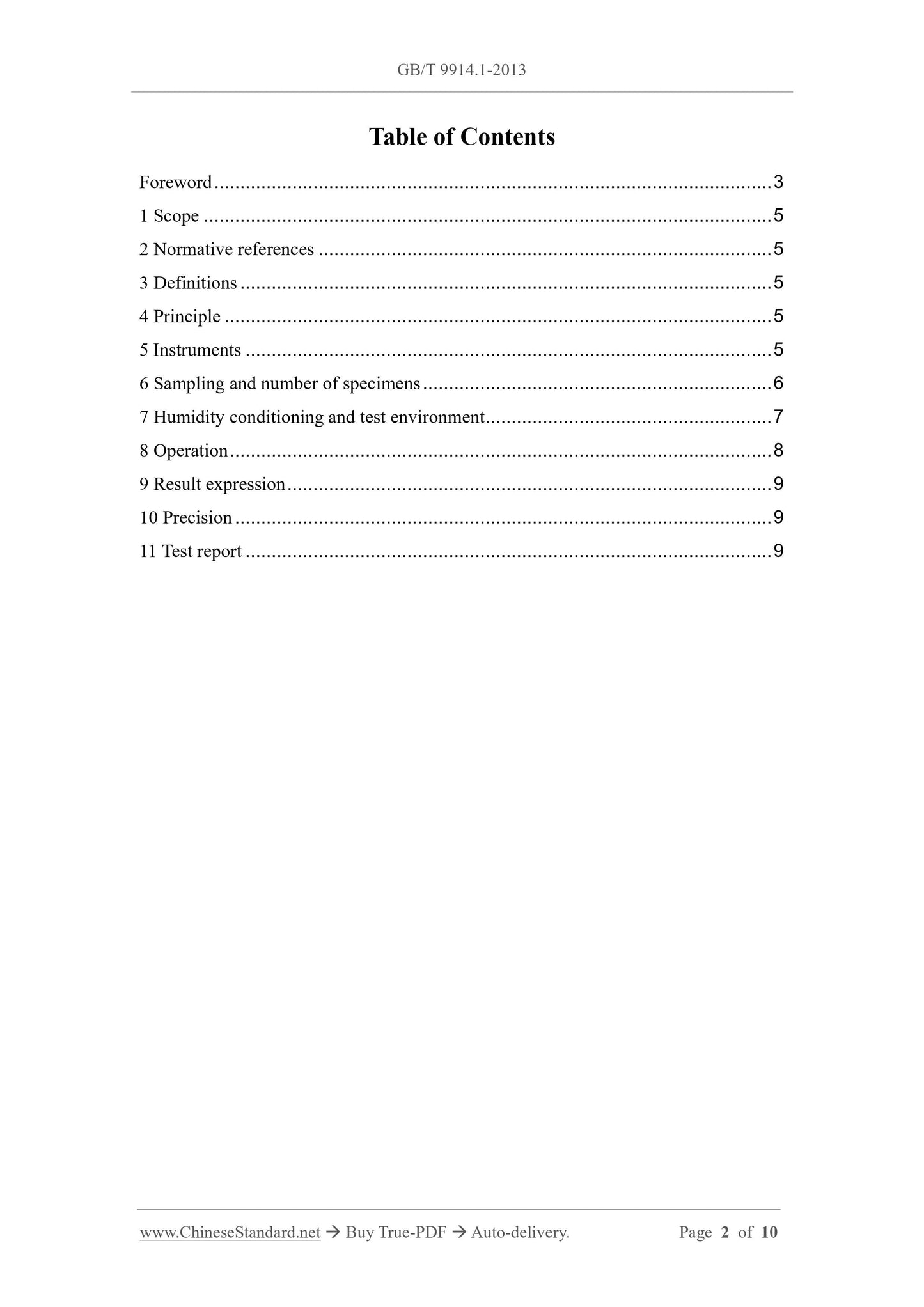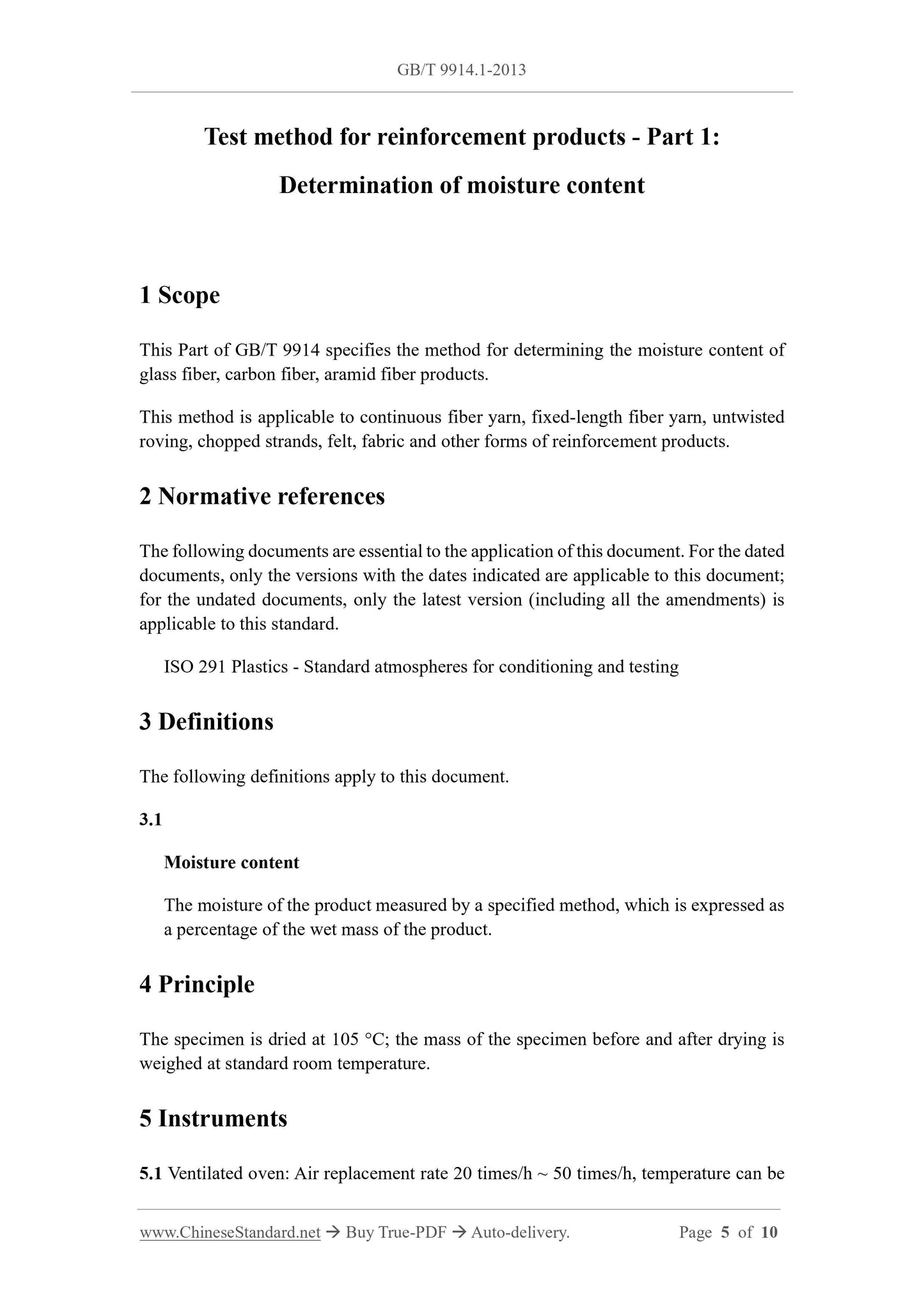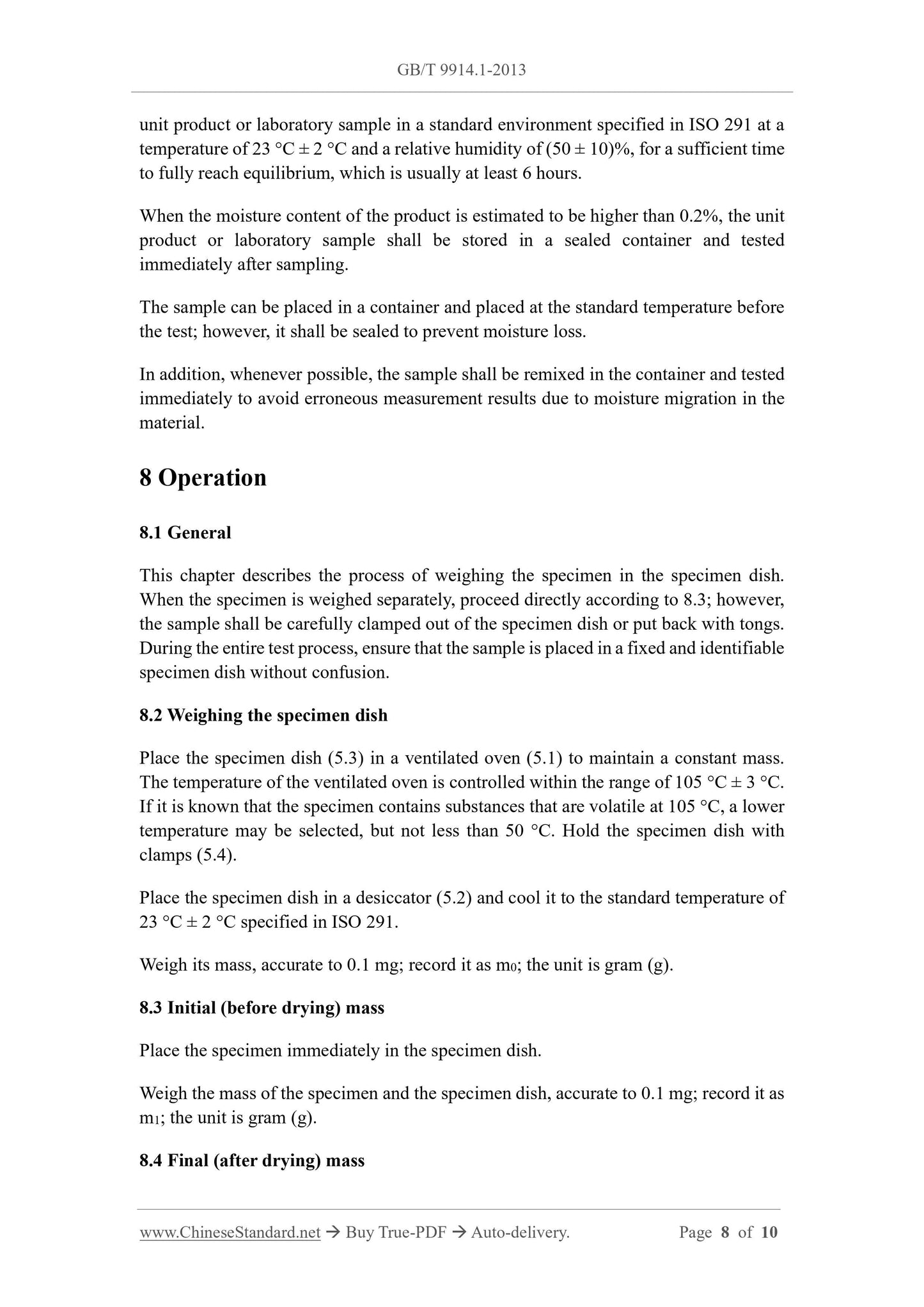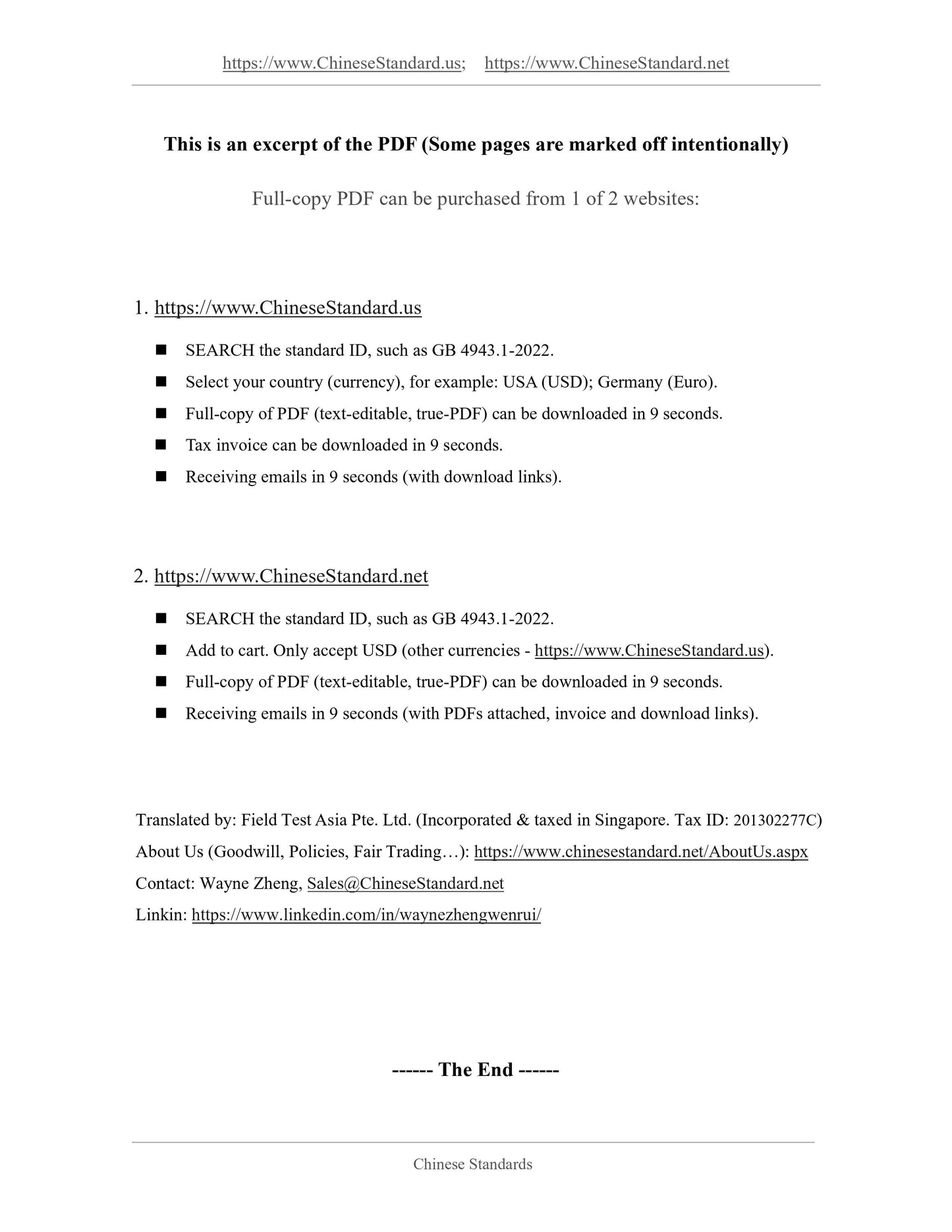1
/
の
6
PayPal, credit cards. Download editable-PDF and invoice in 1 second!
GB/T 9914.1-2013 English PDF (GBT9914.1-2013)
GB/T 9914.1-2013 English PDF (GBT9914.1-2013)
通常価格
$115.00 USD
通常価格
セール価格
$115.00 USD
単価
/
あたり
配送料はチェックアウト時に計算されます。
受取状況を読み込めませんでした
Delivery: 3 seconds. Download true-PDF + Invoice.
Get Quotation: Click GB/T 9914.1-2013 (Self-service in 1-minute)
Historical versions (Master-website): GB/T 9914.1-2013
Preview True-PDF (Reload/Scroll-down if blank)
GB/T 9914.1-2013: Test method for reinforcement products -- Part 1: Determination of moisture content
GB/T 9914.1-2013
GB
NATIONAL STANDARD OF THE
PEOPLE’S REPUBLIC OF CHINA
ICS 59.100.10
Q 36
GB/T 9914.1-2013 / ISO 3344:1997
Replacing GB/T 9914.1-2001
Test method for reinforcement products - Part 1:
Determination of moisture content
(ISO 3344:1997, Reinforcement products - Determination of moisture content, IDT)
ISSUED ON: NOVEMBER 27, 2013
IMPLEMENTED ON: AUGUST 01, 2014
Issued by: General Administration of Quality Supervision, Inspection and
Quarantine of PRC;
National Standardization Administration.
Table of Contents
Foreword ... 3
1 Scope ... 5
2 Normative references ... 5
3 Definitions ... 5
4 Principle ... 5
5 Instruments ... 5
6 Sampling and number of specimens ... 6
7 Humidity conditioning and test environment ... 7
8 Operation ... 8
9 Result expression ... 9
10 Precision ... 9
11 Test report ... 9
Test method for reinforcement products - Part 1:
Determination of moisture content
1 Scope
This Part of GB/T 9914 specifies the method for determining the moisture content of
glass fiber, carbon fiber, aramid fiber products.
This method is applicable to continuous fiber yarn, fixed-length fiber yarn, untwisted
roving, chopped strands, felt, fabric and other forms of reinforcement products.
2 Normative references
The following documents are essential to the application of this document. For the dated
documents, only the versions with the dates indicated are applicable to this document;
for the undated documents, only the latest version (including all the amendments) is
applicable to this standard.
ISO 291 Plastics - Standard atmospheres for conditioning and testing
3 Definitions
The following definitions apply to this document.
3.1
Moisture content
The moisture of the product measured by a specified method, which is expressed as
a percentage of the wet mass of the product.
4 Principle
The specimen is dried at 105 °C; the mass of the specimen before and after drying is
weighed at standard room temperature.
5 Instruments
5.1 Ventilated oven: Air replacement rate 20 times/h ~ 50 times/h, temperature can be
controlled at 105 °C ± 3 °C or selected temperature ±3 °C (see Chapter 4).
5.2 Dryer: Filled with suitable desiccant, such as silica gel, calcium chloride or
phosphorus pentoxide.
5.3 Specimen dish: Made of heat-resistant material, which can maximize air circulation
on the specimen surface and prevent specimen loss, such as ceramic crucible or stainless
steel mesh basket.
Note: If there is no mass loss when the specimen is transferred from the specimen dish to the
oven, several specimens can be placed in one specimen dish.
5.4 Stainless steel clamps: Used to clamp the specimen and the specimen dish.
5.5 Balance: Accurate to 0.1 mg.
5.6 Polished metal template and suitable cutting tools: Such as knife, scissors or disc
knife (for woven fabrics and felt).
Both of these can be replaced by punching devices.
5.7 Weighing bottle with stopper: Used for weighing aramid fiber yarn or weighing
specimens with an estimated moisture content exceeding 0.2% (such as specimens
taken from the center of the package or wet chopped strands).
6 Sampling and number of specimens
6.1 Sampling
6.1.1 General
Unless otherwise required by the product specification or the test client, sampling shall
be carried out as follows.
6.1.2 Continuous fiber yarn, staple yarn, roving
The sampling method selected shall be able to detect the moisture content of the surface
layer of the package.
Remove the outer layer of the package and take a certain length of yarn as a specimen.
The mass of each specimen is at least 5 g, preferably between 15 g and 30 g.
If the moisture content of the yarn tends to increase toward the center of the package,
the product specification or the test client may specify that one or more specimens be
taken from one or more locations of the package for testing. When selecting the
specimen at the center, the outer yarn shall be cut carefully to avoid damaging the
specimen. The specimens shall be weighed as quickly as possible. To this end, the
unit product or laboratory sample in a standard environment specified in ISO 291 at a
temperature of 23 °C ± 2 °C and a relative humidity of (50 ± 10)%, for a sufficient time
to fully reach equilibrium, which is usually at least 6 hours.
When the moisture content of the product is estimated to be higher than 0.2%, the unit
product or laboratory sample shall be stored in a sealed container and tested
immediately after sampling.
The sample can be placed in a container and placed at the standard temperature before
the test; however, it shall be sealed to prevent moisture loss.
In addition, whenever possible, the sample shall be remixed in the container and tested
immediately to avoid erroneous measurement results due to moisture migration in the
material.
8 Operation
8.1 General
This chapter describes the process of weighing the specimen in the specimen dish.
When the specimen is weighed separately, proceed directly according to 8.3; however,
the sample shall be carefully clamped out of the specimen dish or put back with tongs.
During the entire test process, ensure that the sample is placed in a fixed and identifiable
specimen dish without confusion.
8.2 Weighing the specimen dish
Place the specimen dish (5.3) in a ventilated oven (5.1) to maintain a constant mass.
The temperature of the ventilated oven is controlled within the range of 105 °C ± 3 °C.
If it is known that the specimen contains substances that are volatile at 105 °C, a lower
temperature may be selected, but not less than 50 °C. Hold the specimen dish with
clamps (5.4).
Place the specimen dish in a desiccator (5.2) and cool it to the standard temperature of
23 °C ± 2 °C specified in ISO 291.
Weigh its mass, accurate to 0.1 mg; record it as m0; the unit is gram (g).
8.3 Initial (before drying) mass
Place the specimen immediately in the specimen dish.
Weigh the mass of the specimen and the specimen dish, accurate to 0.1 mg; record it as
m1; the unit is gram (g).
8.4 Final (after drying) mass
Get Quotation: Click GB/T 9914.1-2013 (Self-service in 1-minute)
Historical versions (Master-website): GB/T 9914.1-2013
Preview True-PDF (Reload/Scroll-down if blank)
GB/T 9914.1-2013: Test method for reinforcement products -- Part 1: Determination of moisture content
GB/T 9914.1-2013
GB
NATIONAL STANDARD OF THE
PEOPLE’S REPUBLIC OF CHINA
ICS 59.100.10
Q 36
GB/T 9914.1-2013 / ISO 3344:1997
Replacing GB/T 9914.1-2001
Test method for reinforcement products - Part 1:
Determination of moisture content
(ISO 3344:1997, Reinforcement products - Determination of moisture content, IDT)
ISSUED ON: NOVEMBER 27, 2013
IMPLEMENTED ON: AUGUST 01, 2014
Issued by: General Administration of Quality Supervision, Inspection and
Quarantine of PRC;
National Standardization Administration.
Table of Contents
Foreword ... 3
1 Scope ... 5
2 Normative references ... 5
3 Definitions ... 5
4 Principle ... 5
5 Instruments ... 5
6 Sampling and number of specimens ... 6
7 Humidity conditioning and test environment ... 7
8 Operation ... 8
9 Result expression ... 9
10 Precision ... 9
11 Test report ... 9
Test method for reinforcement products - Part 1:
Determination of moisture content
1 Scope
This Part of GB/T 9914 specifies the method for determining the moisture content of
glass fiber, carbon fiber, aramid fiber products.
This method is applicable to continuous fiber yarn, fixed-length fiber yarn, untwisted
roving, chopped strands, felt, fabric and other forms of reinforcement products.
2 Normative references
The following documents are essential to the application of this document. For the dated
documents, only the versions with the dates indicated are applicable to this document;
for the undated documents, only the latest version (including all the amendments) is
applicable to this standard.
ISO 291 Plastics - Standard atmospheres for conditioning and testing
3 Definitions
The following definitions apply to this document.
3.1
Moisture content
The moisture of the product measured by a specified method, which is expressed as
a percentage of the wet mass of the product.
4 Principle
The specimen is dried at 105 °C; the mass of the specimen before and after drying is
weighed at standard room temperature.
5 Instruments
5.1 Ventilated oven: Air replacement rate 20 times/h ~ 50 times/h, temperature can be
controlled at 105 °C ± 3 °C or selected temperature ±3 °C (see Chapter 4).
5.2 Dryer: Filled with suitable desiccant, such as silica gel, calcium chloride or
phosphorus pentoxide.
5.3 Specimen dish: Made of heat-resistant material, which can maximize air circulation
on the specimen surface and prevent specimen loss, such as ceramic crucible or stainless
steel mesh basket.
Note: If there is no mass loss when the specimen is transferred from the specimen dish to the
oven, several specimens can be placed in one specimen dish.
5.4 Stainless steel clamps: Used to clamp the specimen and the specimen dish.
5.5 Balance: Accurate to 0.1 mg.
5.6 Polished metal template and suitable cutting tools: Such as knife, scissors or disc
knife (for woven fabrics and felt).
Both of these can be replaced by punching devices.
5.7 Weighing bottle with stopper: Used for weighing aramid fiber yarn or weighing
specimens with an estimated moisture content exceeding 0.2% (such as specimens
taken from the center of the package or wet chopped strands).
6 Sampling and number of specimens
6.1 Sampling
6.1.1 General
Unless otherwise required by the product specification or the test client, sampling shall
be carried out as follows.
6.1.2 Continuous fiber yarn, staple yarn, roving
The sampling method selected shall be able to detect the moisture content of the surface
layer of the package.
Remove the outer layer of the package and take a certain length of yarn as a specimen.
The mass of each specimen is at least 5 g, preferably between 15 g and 30 g.
If the moisture content of the yarn tends to increase toward the center of the package,
the product specification or the test client may specify that one or more specimens be
taken from one or more locations of the package for testing. When selecting the
specimen at the center, the outer yarn shall be cut carefully to avoid damaging the
specimen. The specimens shall be weighed as quickly as possible. To this end, the
unit product or laboratory sample in a standard environment specified in ISO 291 at a
temperature of 23 °C ± 2 °C and a relative humidity of (50 ± 10)%, for a sufficient time
to fully reach equilibrium, which is usually at least 6 hours.
When the moisture content of the product is estimated to be higher than 0.2%, the unit
product or laboratory sample shall be stored in a sealed container and tested
immediately after sampling.
The sample can be placed in a container and placed at the standard temperature before
the test; however, it shall be sealed to prevent moisture loss.
In addition, whenever possible, the sample shall be remixed in the container and tested
immediately to avoid erroneous measurement results due to moisture migration in the
material.
8 Operation
8.1 General
This chapter describes the process of weighing the specimen in the specimen dish.
When the specimen is weighed separately, proceed directly according to 8.3; however,
the sample shall be carefully clamped out of the specimen dish or put back with tongs.
During the entire test process, ensure that the sample is placed in a fixed and identifiable
specimen dish without confusion.
8.2 Weighing the specimen dish
Place the specimen dish (5.3) in a ventilated oven (5.1) to maintain a constant mass.
The temperature of the ventilated oven is controlled within the range of 105 °C ± 3 °C.
If it is known that the specimen contains substances that are volatile at 105 °C, a lower
temperature may be selected, but not less than 50 °C. Hold the specimen dish with
clamps (5.4).
Place the specimen dish in a desiccator (5.2) and cool it to the standard temperature of
23 °C ± 2 °C specified in ISO 291.
Weigh its mass, accurate to 0.1 mg; record it as m0; the unit is gram (g).
8.3 Initial (before drying) mass
Place the specimen immediately in the specimen dish.
Weigh the mass of the specimen and the specimen dish, accurate to 0.1 mg; record it as
m1; the unit is gram (g).
8.4 Final (after drying) mass
Share












